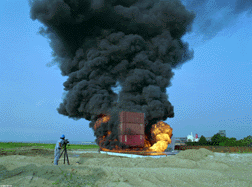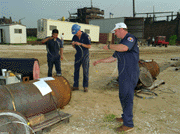
ALBUQUERQUE, N.M. — Nuclear-material shipping casks transported inside standard steel shipping containers can survive large fires and still protect their contents and prevent radioactive material releases, according to preliminary results from recent fire endurance tests.
Conducted near Mobile, Alabama, by Sandia National Laboratories for the U.S. Department of Energy’s National Transportation Program, the tests exposed nuclear-material casks inside International Standards Organization (ISO) shipping containers to a fire fueled by 4,000 gallons of JP-8 jet fuel. The containers tested measure 20 feet long, eight feet tall, and eight feet wide, and weigh about 5,000 pounds empty. (Other standard ISO containers are up to 50 feet long.) The multi-purpose containers are used to ship cargo by sea, rail, and road.
The primary purpose of the tests was to determine whether the nuclear-material casks that are routinely shipped inside the ISO containers could withstand a major fire on a ship’s open deck, says Sandia’s technical project leader Joe Koski. The tests were also designed to quantify typical container fire conditions and compare them to conditions that typically exist during land-based shipping accidents.
The tests involved nine shipping containers and were conducted at the Coast Guard’s Fire and Safety Detachment on Little Sand Island in the middle of the bay south of Mobile. The facility is used by the Coast Guard and other government-funded groups for marine fire and safety tests.

Several types and sizes of radioactive-material packages were inside one of the shipping containers during the tests, but no nuclear materials were involved. Other containers were packed only with steel pipe calorimeters simulating casks, and still others contained combustible materials such as wood pallets, cardboard, and paper.
The fire was set on July 30 with the jet fuel burning for about one hour, although combustible paper, cardboard, and wood in some containers continued to smolder more than a day. JP-8 fuel burns at temperatures up to 2,200 degrees F. Flames reached more than 30 feet high at times.
After the fire, the unloaded radioactive materials packages were examined and appeared to be in good condition. The packages are being returned to Albuquerque for further inspection and analysis.
“Although we need to study the test data in detail,” says Koski, “we are encouraged by the preliminary results and believe the casks in combination with the containers will do exactly what they are designed to do – protect their contents and prevent the release of potentially hazardous radiation if they are ever involved in an accident of this type.”
Spent nuclear fuel and other nuclear materials are typically moved internationally aboard cargo ships, in casks placed inside the standard shipping containers. Casks must meet standards set by the Code of Federal Regulations (10CFR71) in the U.S. or International Atomic Energy Agency (IAEA) Safety Series 6 for international shipments.
“To the best of our knowledge, nuclear-material shipping casks have never been involved anywhere in the world in a severe fire accident like we simulated,” Koski says. But he adds that ISO standard shipping containers are used extensively, so knowledge of the protection they offer is valuable to analysts trying to understand the safety issues surrounding such shipments.
Sandia’s tests were designed to answer questions about the actual temperatures and heat transfer phenomena in and among the containers in a configuration typical of on-deck stowage where oxygen is available to contribute to the intensity of a fire, says Koski.
Sandia used a suite of scientific instruments including calorimeters, thermocouples, and data-recording devices that it built or configured specifically for these tests.
Koski and several others in Sandia’s Transportation Systems Development Department, including Ray Dukart, Jeff Bobbe, Mike Arviso, and manager Glenn Hohnstreiter, had major roles in the tests. The tests contribute to a cooperative research program sponsored by the IAEA and funded by the U.S. Department of Energy. Final results will be published as soon as possible and provided to agencies and companies around the world that are concerned with nuclear materials shipping safety.
“These results will not be an end in themselves,” says Koski. “Using what we learn, we plan to develop well-calibrated computer models that can predict the behavior of nuclear-material shipping casks when exposed to various types of fire scenarios. Accurate computer models could save lots of money and time when approval is being sought for shipping potentially hazardous materials.”
Sandia National Laboratories is a multiprogram Department of Energy laboratory, operated by a subsidiary of Lockheed Martin Corporation. With about 7,500 employees and facilities in Albuquerque, N.M., and Livermore, Calif., Sandia has major R&D responsibilities in national security, energy, environmental technologies, and economic competitiveness.
Color photographs available
Technical contact:
Joe Koski, jakoski@sandia.gov, (505) 845-9572